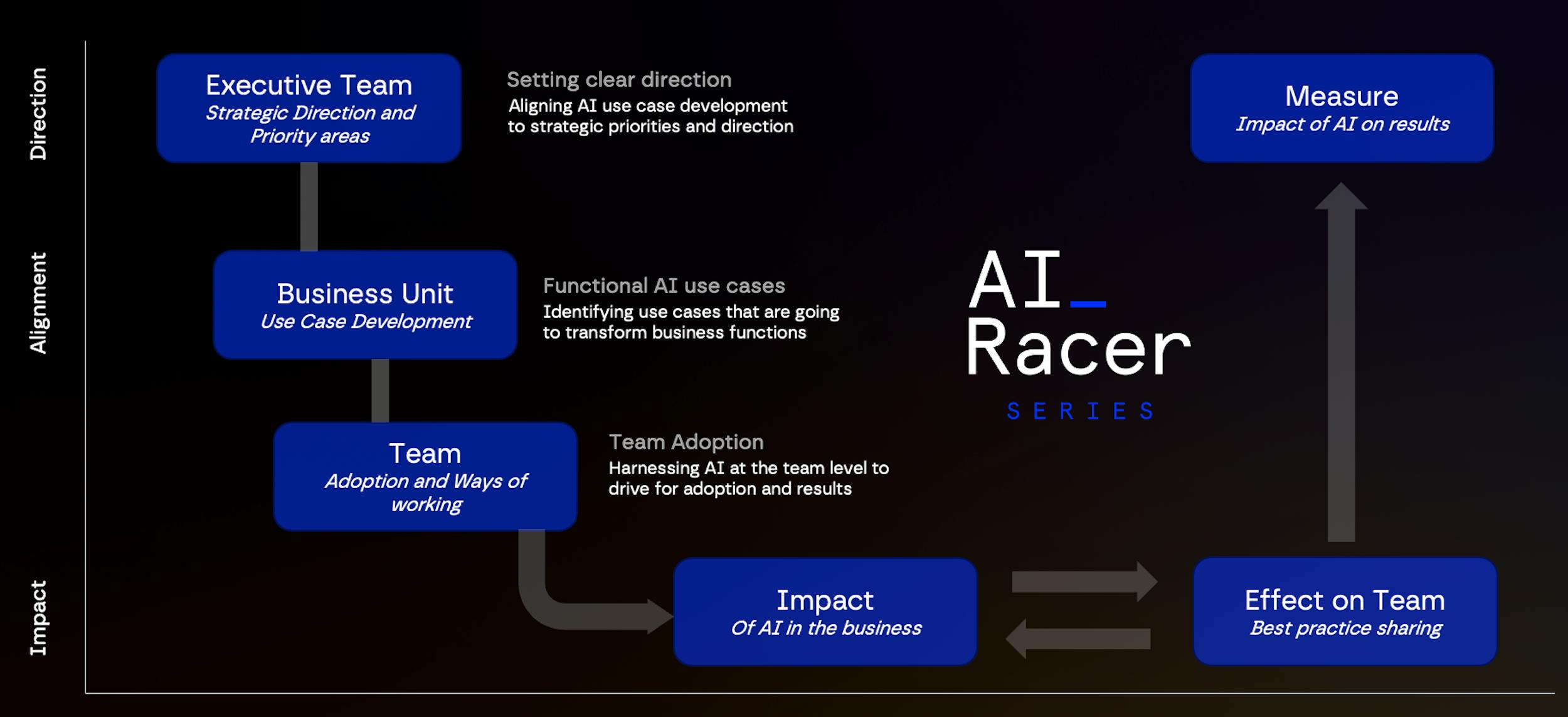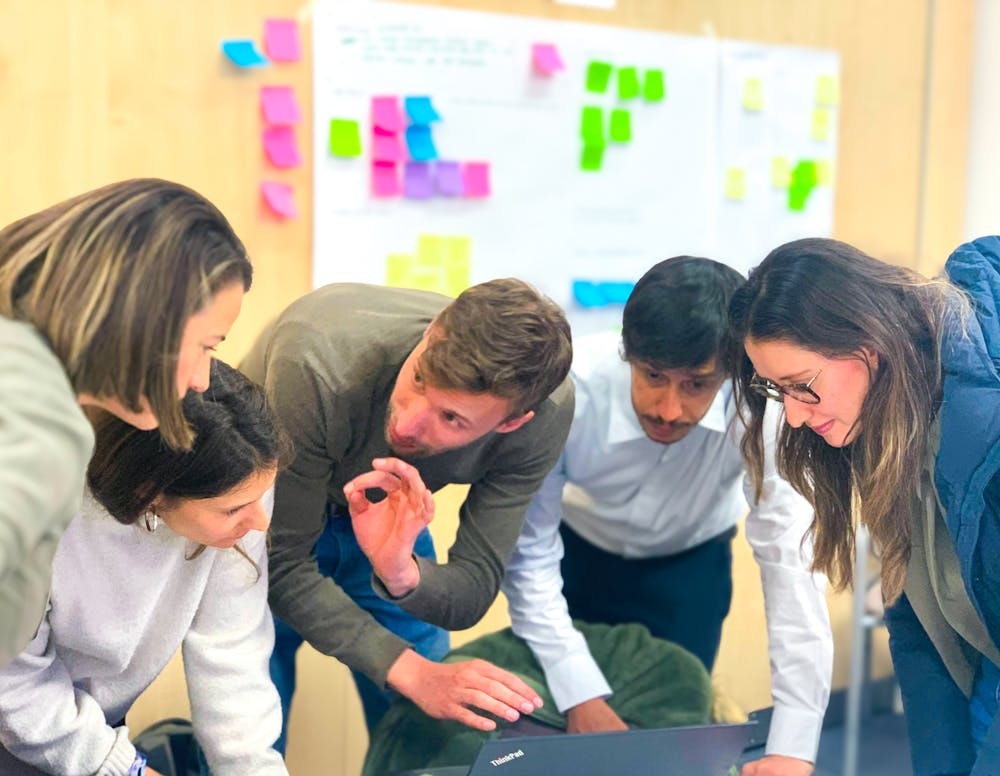AI as a competitive advantage

Accelerating Transformation
see6's AI Use Case Development and Adoption Cascade Model is a comprehensive, end-to-end framework designed to accelerate AI adoption in a mission-driven way. This model guides organizations through every stage of the AI lifecycle—from initial ideation and strategy formulation to the full implementation and iterative refinement of AI solutions—ensuring that each step is aligned with broader business objectives. Complementing this approach, the AI Racer Series focuses on harmonizing both organizational and individual capabilities, enabling teams to systematically identify, develop, and scale high-impact AI use cases.

A new era for AI GTM
Step 1
Setting clear direction

Step 1
Setting clear direction
Aligning AI use case development with your organization’s strategic priorities and direction is a foundational step in successfully integrating AI across all levels of the business. This process begins with actively engaging the executive team to capture their vision and clearly articulate the strategic priorities that drive the organization. By doing so, every AI initiative is directly tied to the company’s overarching goals, ensuring that technological investments translate into tangible business outcomes. This deliberate alignment allows the organization to systematically track the impact of AI adoption, linking specific use cases to measurable improvements in performance and value. Furthermore, by embedding strategic guidance into the AI development process from the outset, the organization avoids the common pitfall of siloed projects that operate independently of the business’s long-term objectives. Instead, this integrated approach fosters a cohesive transformation journey where AI investments and new capabilities are purposefully directed towards achieving what the business is setting out to accomplish, ultimately enhancing efficiency, competitiveness, and overall success.
Step 2
Business Unit use cases

Step 2
Business Unit use cases
AI Racer initiates its transformative journey by first pinpointing AI use cases that have the potential to fundamentally reshape business functions. In close alignment with the organization’s strategic priorities, the process involves engaging directly with various business units to uncover opportunities that can radically change the way they operate. For instance, collaborating with a regional sales team might involve exploring AI-driven solutions that redefine daily customer interactions, leading to more personalized engagement and ultimately boosting sales performance. Similarly, partnering with the HR leadership team can help identify groundbreaking applications of AI that transform internal support systems, from enhancing talent acquisition and employee development to streamlining routine administrative tasks. The underlying mindset is one of pursuing transformational change rather than settling for incremental improvements; AI Racer is focused on uncovering those high-impact use cases that not only excite teams but also deliver clear, tangible business value.
Step 3
Team Adoption

Step 3
Team Adoption
Step 3 is all about team engagement and adoption, focusing on driving change within functional areas by working directly with teams to reimagine their day-to-day operations in an AI-enhanced environment. This step involves facilitating in-depth discussions to determine what new ways of working need to be adopted and identifying the behavioral changes required in ourselves and our colleagues. For instance, teams might explore how AI capabilities can transform decision-making by providing real-time insights or how automated knowledge retrieval systems can improve access to critical organizational data. The conversations extend to identifying the specific behaviors and collaborative practices that will not only foster an AI-ready culture but also drive competitive advantage. The outcome of this engagement is the development of a codified framework or a set of best practices that clearly outline how to effectively integrate AI into daily operations. This structured approach not only increases the likelihood of successful AI adoption but also ensures that every team member is aligned with the strategic vision, actively contributing to and championing the transformation.
Step 4
Sharing best practice

Step 4
Sharing best practice
Following the initial launch of the AI Racer Game with teams, the next phase is dedicated to embedding best-in-class knowledge sharing into every facet of daily operations. This stage is crucial for ensuring that every team member is actively engaged and that no one is left behind in the transformation journey. The systems and processes established in earlier phases must remain aligned with the commitments made by individuals, emphasizing accountability and the consistent sharing of best practices across the organization. In this phase, teams are encouraged to document, disseminate, and adopt innovative strategies that enhance overall performance, fostering a culture of continuous improvement. To further drive engagement, AI Racer introduces dynamic elements such as departmental standings, leaderboards, cross-functional team activities, and individual recognition initiatives. These tools are designed not only to motivate and reward outstanding contributions but also to promote a spirit of healthy competition and collaborative learning. By integrating these practices, the organization ensures that the momentum gained from early AI adoption is sustained, ultimately leading to a more agile, informed, and cohesive workforce.
Step 5
Measuring Impact

Step 5
Measuring Impact
The final and most important phase of the transformation is to measure the impact of AI on your business strategy. This stage creates a continuous feedback loop back to the strategic direction outlined in Step 1, ensuring that every investment in AI, every new way of working, and every initiative across people, process, and technology remains aligned with your desired strategic outcomes. At this point, organizations rigorously evaluate performance metrics and key indicators to determine whether the AI-driven changes are delivering the anticipated benefits. This measurement phase not only validates the effectiveness of current initiatives but also provides critical insights that can inform future improvements and strategic adjustments. It offers a vital opportunity for transformation leaders and business executives to compile a compelling narrative—sharing success stories and data-driven results with the broader leadership team—to demonstrate how AI is generating competitive advantage. By transparently showcasing these achievements, the organization reinforces commitment to the transformation journey, ensuring that the strategic vision and operational execution continue to evolve in sync with the ever-changing business landscape.
Get in touch
Learn how to drive competitive advantage by integrating people, processes, and technology into a cohesive AI adoption strategy. Don't let your organization be left behind—take the first step towards revolutionizing your business today.